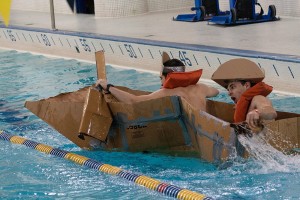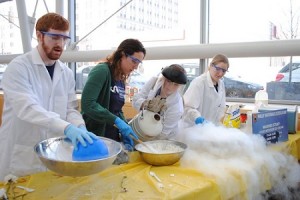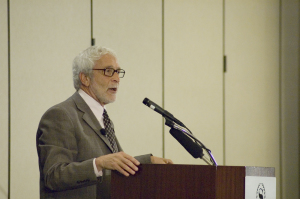Two teams of Drexel students raced recycled cardboard boats in the DAC swimming pool at the sixth annual Rec Recycle Regatta Feb. 22. The Recycle Regatta is a yearly environment-friendly competition where students construct boats and paddles made entirely of cardboard and duct tape, and then race them along the pool.
For the last few years, Jillian Formanski, coordinator of Intramural Sports has run the event. She said that Recycle Regatta is “a fun event that’s not the typical intramural sporting event … [and] is just something different, especially for the non-traditional athletes to try to get involved.”
Competitors can also win awards at the event. The Black Pearl award is given to the team who crosses the length of the pool the fastest. The Mayflower award recognizes the team with the best construction. The Nina, Pinta and Santa Maria award goes to the team with the best sportsmanship and team spirit. The Titanic award goes to the boat with the best sinking moment. The participating teams come to compete but also to have fun. “There’s a lot of camaraderie among the people in the boats and competing against the other teams as well,” Formanski said.
In the past, the number of participating teams fluctuated, with up to six teams showing up in one year. This year, there were two competitors, whose boats were named the Titanic++ and the USS Sandy. The Titanic++ was built and decorated to resemble a pirate ship, complete with pirate hats and swords for crewmembers Tomer Shemesh and Andrew DiNunzio, both pre-junior computer science majors. The USS Sandy, named for a crew member who ended up not being able to attend the event, was manned by senior communication major Stan Wright and senior business and engineering major Ryan Wendl.
“I got an email and I was just like, we have to do this! I showed him and said, ‘we’re doing this, it’s not an option,’” Shemesh said on what brought him to the regatta.
His co-captain DiNunzio added, “I wasn’t sure if I wanted to do it at first, but then I was like, yeah, let’s go all out!”
The crew of the Titanic++ spent about 10 hours working on designing and building their cardboard masterpiece. They even used mathematical formulas involving buoyancy and force to see how far into the water their boat would sink in the pool once they got in. When asked which award they would be most pleased to win, they responded that the Black Pearl award would be the most apropos, given their pirate theme.
The USS Sandy, made much more colorful with the addition of some last minute sharpie art by Wright, was put together in a little over three hours. The design relied on a wide flat base with three triangular hulls on the bottom to keep the boat above water, as opposed to the open-box format used for the Titanic++.
The event was attended by 10 spectators who cheered on their respective teams as the regatta ensued. Getting into the water with a huge cardboard box proved challenging, but both teams got started quickly.
The Titanic++ had a slow start, but then steadily advanced to the end of the pool in an impressive one minute and two seconds, possibly the fastest time ever demonstrated at the regatta, according to a lifeguard. Sandy, on the other hand, was not so fortunate. About a third of the way across the pool, the boat and its crew experienced an unfortunate but amusing descent into the water. The boat was pulled across by Wright and Wendl.
After making it across, Formanski suggested that the crew of the Titanic ++ attempted to make it back across the pool again, adding that she had never seen anybody succeed with this. Though the crew tried valiantly, they only made it about a quarter of the way back across the pool before the water-logged cardboard stopped all movement.
At the end of the event, the crew of the Titanic ++ won the Black Pearl and Mayflower awards, and the crew of the USS Sandy won the Titanic award.
The post Students compete in Recycle Regatta 2015 appeared first on The Triangle.













